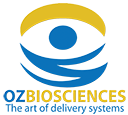
Lullaby is the ideal siRNA transfection reagent for gene silencing. Relying on the TEE-technology, it has been successfully tested on numerous cell lines, reaching up to 90% gene silencing with high reproducibility and a very low toxicity. RNA interference is a powerful technique to shut down genes expression in cells and organisms. This silencing effect constitutes a very helpful tool to study gene’s function and a promising approach for new therapeutic treatments. Short RNA duplexes (siRNA: small interfering RNA, shRNA: small hairpin RNA and dsRNA: double strand RNA) are extremely selective by interacting and inducing the degradation of their specific mRNA targets and thereby inhibit the resulting protein production. Lullaby® siRNA Transfection Reagent introduces the siRNA duplexes in a variety of cells with a very high efficiency leading to exceptional knockdown effects with low doses of siRNA.
"We initially collated a transfection reagent library of 26 reagents...By far, our preferred reagent is Lullaby from OZ Biosciences. We have used this reagent in over 20 cell lines and have found it essential in enabling siRNA screens in hard to tranfect cell lines..., with minimal toxicity"
Emma L. Shanks (2014) Strategic siRNA Screening Approaches to Target Cancer at the Cancer Research UK Beaston Institute, Combinatorial Chemistry & High Throughput Screening, 17:328-332
![]()
- Effective with very low doses of siRNA
- Minimized off-target effects
- Suitable for siRNA, shRNA, dsRNA, etc.
- Applicable to a broad range of cells
- Serum compatible & Non toxic
- Straightforward protocol
Lullaby transfection reagent:
Sizes:
- 500 µL: Up to 1000 assays
- 1000 µL: Up to 2000 assays
- 3 x 1000 µL: Up to 6000 assays
Storage: + 4°C
Shipping conditions: Room temperature
Please log in or register to see the prices for your country
ebiomall.com






>
>
>
>
>
>
>
>
>
>
>
>
上海好多的供应商的,具体还是看你选择了,其实试剂盒产品都差不多,什么远慕生物,古朵生物...好多的额
用双氧水去除过氧化物酶时,我是自己配的3%双氧水滴到片上而非将片浸入双氧水,这样可否?
用博士德的DAB染色,配制方法为:1mlH20中加入DAB、H2O2、TBS各一滴,我配制的时候发现将DAB加入H20时很容易沉淀,要震荡才能混匀,且将配好的DAB滴到玻片上时,DAB会结为很小块的微颗粒悬浮在液体中但并不染色,是否DAB有问题?
现在打算换中衫的试剂盒,代理商说中衫的试剂盒包括了二抗和DAB,想请教一下该试剂盒的具体内容有些什么?
万分感谢!
GlucosestarvationcausestranslocationofAMPKβ2tothelysosomeinHEK-293cellsthatisdependentonN-myristoylation.Theexperimentwasperformedinβ2KOcellsasinFig.1c,exceptthatthelysosomalMarkerLAMP1(taggedwithRFP)wasco-expressedwiththewild-typeormutantAMPKβ2.Upperpanelsshowmergedimagesstainedblue(4′,6-diamidino-2-phenylindole(DAPI),nuclei),red(LAMP1,lysosomes)andgreen(AMPKβ2,detectedusingantibodyvalidatedine),incellsincubatedwithorwithoutglucosefor20 min.Lowersmallpanelsaremagnificationsoftheareasindicatedbydashedboxesintheupperpanels,showing(LtoR)redandgreenchannelsandmergedimages.
下面的这段话是图注,图注的意思我明白,但是我想知道merge后的图看什么颜色的荧光,蓝色是细胞核,红色是lysosome(位于胞质),绿色是AMPKβ2,该实验是想观察AMPKβ2是否转位到lysosome上了,如果确实发生了AMPKβ2转位到lysosome上,那么merge后是红色与绿色融合在一起,是吗?融合在一起发什么颜色的光了?
本人对软骨石蜡切片做了MMP-13的免疫组化染色,首次做,无法判断染色部位,请各位帮忙看一下
1)做免疫组化的片子最好不要同时做HE染色,因为那样会掩盖阳性着色的结果;而且用苏木素复染细胞核也是淡染,若要在免疫组化的片子上观察形态学的改变,除非有非常典型的表现,一般是有很大的难度的。
2)你是培养的细胞做免疫组化吗?如果是的话,那就每个样本只有一张片子吧?唯一的办法是进行免疫双染,同时做CD34和AFP(甲胎蛋白)。我觉得后者阳性便可以或多或少的获得向肝细胞分化的证据。
3)用HE染色来识别造血干细胞向肝细胞分化,也就是说要看到肝细胞的典型形态学改变后才可以下结论。问题是:早期的肝细胞仅凭形细胞态学观察并不能很容易的被识别。病理大夫看组织切片,重要的是看其组织学结构,对肝细胞也是这样。如果单拿出来一个细胞,还是培养的细胞,染色后真的不容易区分。所以我觉得你设计的用HE染色来确定早期细胞向哪个方向分化不是很有说服力。
4)如果是切片,也就是说每个样本可以有多张切片,那可以在连续切片上分别染CD34和AFP,拍照时选择相同视野,也有一定说服力。但是还是不如双染法更可靠。
5)用双染最大的问题在于:这两者都表达在胞浆中,染色容易相互覆盖。所以在双染的方法选择上你还要再考虑一下,可不可以用免疫荧光双染?这样也很有说服力的









